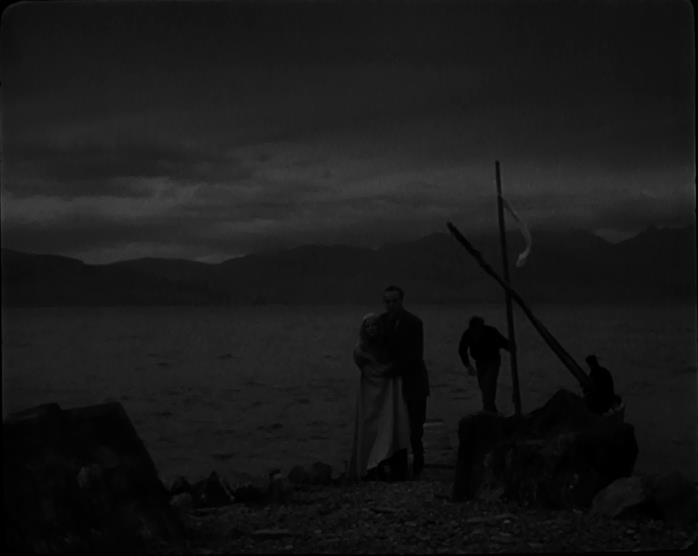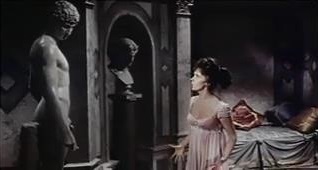L’Eternel Retour

With
Jean Marais “and for the first time on the screen Yvonne de Bray”, Les Parents terribles
on a Wagnerian theme under the German Occupation, astoundingly.
Bosley
Crowther of the New
York Times in 1948, “completely bizarre and absurd.”
Tom Milne (Time Out), “a sadly
neglected film...”
The opening
titles are shown over a vertical hand advancing toward the camera, “ils ne passeront pas.”
And you will
observe precisely the technique deployed in the later film, which goes to prove
Cocteau the auteur or Delannoy il miglior fabbro.
Question of
cousin Patrice bringing home Nathalie for Uncle Marc, what could be more French
except Franju’s Thérèse Desqueyroux, auprès de ma blonde...
¡Ah, los gringos
otra vez! (Peckinpah, The Wild Bunch), it works both ways,
Cocteau says that certain legends hold sway “sans que leurs héros s’en doutent” and takes his title from Nietzsche,
“eternal return of very simple circumstances that make up the most famous
of all the great stories of the heart... without their heroes
suspecting.”
Pauline Kael, “absurdly glamorous lovers; though the film has
the decorative look of ballet and is heavy and stilted...” The lovers are
no more glamorous than Veronica Lake and Alan Ladd, the picture is finely
dressed and very nimble. “Quelle
comédie!”
“Quelle trrragédie!” And this remark, “à ta place, Marc, je surveillerais Patrice.”
The night effects
are particularly noteworthy. Nathalie malade
anticipates a characteristic
intonation of La Belle et la Bête. When the town’s drunken bully died, her
would-be fiancé, they didn’t try to save him but were sad and drank no
more, the idle barman explains.
La Symphonie
pastorale

Mountain
village, winter, sleigh bells in the snow. Ahead of Johnny Belinda
(dir. Jean Negulesco), ahead of The Miracle Worker (dir. Arthur Penn), the blind idiot
“plucked out of the night”, played in adulthood by Michèle Morgan, the priceless word cornement to describe the playing
of an organ pipe after the rich donor’s finger has left the key.
“Now”,
as immemorially pronounced by Troy Maxson, “I
thought he was mad cause I ain’t done my work.
But I see where he was chasing me off so he could have the gal for himself.
When I see what the matter of it was, I lost all fear of my daddy.”
Bosley Crowther of the New
York Times found his wits gathered as seldom if ever again, “an
intense, disturbing film.” Time Out, “correct,
melancholy, icy.” Pat Graham (Chicago Reader), “notoriously an example of French ‘poetic
realism.’” Hal Erickson (Rovi), “audiences... ate up the film like cotton candy.”
The obstreperous
little fool telling the blind girl what direction to take whilst perched on her
back is a fine image of the late Occupation, searching on her hands and knees
in the snow for the shoe he’s missing is another.
It won a prize at
Cannes, likewise Morgan.
The cure for
blindness is G.F. Handel’s conquering hero and no mistake. The game of
checkers all on one side en attendant
is also in Welles’ The Stranger
that year (next year is Monsieur Verdoux, from the director of City Lights, to whom a certain resemblance is apparent).
“C’est ça la neige!” One knows the cellar afterwards even without a light to see by, celui qui me suit ne marchera pas dans les ténèbres.
An influence of Welles is evident in the editing. The score by Auric has
been praised. The Gold Rush is
briefly invoked at the ending, which is remembered by Fritz Lang in Die 1000 Augen des
Dr. Mabuse.
Halliwell’s Film Guide, “curious”.
Les Jeux sont faits

At a place where brownshirts sing their la-la-la in the streets on the
march, a forsaken wife dies poisoned, a resistance leader is gunned down, all
betting is over, “rien ne va plus”, the fortunes of war being what they
are, all is not lost (cf. Renoir’s
Le Caporal épinglé),
a screenplay by the author of Huis clos (dir. Jacqueline Audry)
and screenwriter of Les Sorcières de Salem (dir. Raymond Rouleau).
Certain
conventions of nonexistence prevail as in The
Twilight Zone (Rod Serling), no reflections, unheard, unseen... between
Lang’s Liliom and
Cocteau’s Orphée, with a sort
of concierge, “je vais vous demander une petite
signature. Là. Là! Maintenant vous voilà
mort pour de bon.” The living and
the dead, “je ne me trompe jamais! C’est professionel.”
They meet over a
pickpocket unavailing, “God’s spies.” In the dictator’s
palace with “d’anciens amis”,
the man with the little mustache practicing gesticulations before a mirror. “Allons, bon! Encore des complications.”
“C’est
une belle saloperie d’être mort!” They return to life according to an article,
destined for each other, and briefly act out the division of French society
that brought about defeat, a house divided against itself in the Thirties,
“un amour impossible”,
whereas together they save the daughter of one who has died. The two revenants (on the eve of a general
uprising his colleagues disapprove of his marriage plans, her husband is
“le nouveau secrétaire de la Milice”)
are strictly enjoined to have “confiance” in each other, on pain of “deuil en 24 heures”
(Roland Petit’s joke in Black Tights, dir. Terence Young). “Nous avons perdus...” One embrace only, in Sartre’s beautiful line, “ça
valait la peine de revivre.”
“Il n’y
a plus que nous deux. Nous sommes seuls au monde. Il faut nous aimer, Éve, il faut nous
aimer. C’est notre seul faut.” The knock on the door goes away but, like Orphée,
the expelled résistant
leaves her side to meet his fate. Invisible amidst a shootout between les copains
and la Milice,
he gives a little Gallic shrug of the shoulders that Chaplin made his own (her
name is Charlier).
T.M.P. (New York Times), “Jean-Paul
Sartre’s doctrine of existentialism... neither a stimulating nor
satisfying film... materialistic and contradictory... no particular display of
imagination” (as The Chips Are Down).
Time Out,
“those Left wing movies which loomed large in Europe after 1945.”
Hal Erickson (Rovi), “Sartre’s
traditional defeatism”. Halliwell’s
Film Guide, “somewhat despondent... with morsels of wit.”
The Hunchback of Notre Dame
The forces set in
motion by Hugo’s obscure allegory are given particular divided attention
by Delannoy and his screenwriters, Aurenche and Prévert. There is no end of
pains taken, when you buy your ticket you see Esmeralda dance before the
cathedral to choreography by Massine. She is the Virgin, a gypsy.
Her devotion to
clemency and justice saves the life of Gringoire, failed poet and playwright
whose Jupiter is shouted down at the Feast of Fools.
And so it goes,
the alchemist Frollo craves her, the King of France his imaginary gold. A
scourging satire of the Middle Ages and dark
superstition conveys her to the bellringer Quasimodo, the mob seizes her,
soldiers hang her.
The grand
spectacle of Notre-Dame de Paris is laid in widescreen and color, with
Anthony Quinn as Quasimodo, Gina Lollobrigida as Esmeralda, and Alain Cuny as
Frollo. None of this meant anything to the New York Times.
Maigret tend un piège
An extensive
analysis of the boyhood “genius” who, cut off at the knees, slays
women.
An Edgar to
Simenon, Best Foreign Film.
This is amazingly
poetical, “coiled in new tears to spring farther forward in its
order.”
Bosley Crowther (New York Times), “an exciting
example of the author’s sophisticated work and a beautifully clear and
catchy portrait of the gumshoe.”
There is an
indication of Carné’s Drôle de drame in the construction, a son of a butcher is the
killer.
“Probably
the best Maigret film,” according to Halliwell’s
Film Guide, praising the Parisian ambiance and the skill of the players.
Maigret et l’affaire
Saint-Fiacre
The countess at Moulins, undermined, pillaged, done in. Her son the young
count away in Paris or the Midi at great expense, her secretary whose fiancée
has a taste for Louis XVI, her faithful steward lending to the estate
unselfishly, her doctor, the priest, chauffeur, staff, etc.
Maigret,
an admirer in his youth, son of the estate agent (they remember him roundabout
from school days).
A
classic exercise to isolate the inspector from his confreres Chan, Wong, Poirot,
Marple. Gabin as Maigret doesn’t wring any obvious necks, he is with the
police, his disdain is withering, a few words like a
punchup, massive control.
The
mechanism of death is from Proverbs, a foolish son, his mother’s heart,
and it is foretold in a threatening letter that brings Maigret from his
bailiwick.
Delannoy
is all concentration, tilting up rapidly to identify a building and back down
again for the scene.
There
are indications of an influence on Huston in The List of Adrian Messenger.
Venere Imperiale

Born
of the foam or the lather of a seaside tryst, a poor girl, the Emperor’s
sister, a virtuous girl, bringing home the bacon, Paulette.
The
Grande Armée, a band of brigands. Les Bonapartes.
She may not marry the man she loves. “At Milan,” the General
confides to her, “I slept in a room all marble, thirty feet long!”
The Scarface theme.
Les amours (he calls her “una squaldrina”
and breaks up the furniture)... Lollobrigida, Presle as Josephine, Ferzetti,
Boyd, Girotti, Pellegrin as N.
Delannoy
has a fine flourish or two involving Boyd’s Hussar captain.
Vicereine of Saint-Domingue, balloons and bongo drums
and yellow fever, les nègres...
After that, Principessa Borghese. The Mysteries of the Rosary. In the
studio, “c’è qualche cosa
che—che non va!”
“Me preferite così, Canova?” Return to Paris. Coronation. A heroic ride.
Defeat
and exile.
Screenplay Aurenche et al., cinematography Pogany (Technicolor and Supertechnirama
70), score Lavagnino.
TV Guide, “old-style French picture”. Hal
Erickson (All Movie Guide),
“French/Italian historical spectacle”.

Mary of Nazareth
English-dubbed Marie
de Nazareth is “infinitely great, because infinitely small”,
the threshold of style crossed by Delannoy’s encyclopædic knowledge of
every painting and film on the Savior, he navigates between them all as one or
another exerts its gravitational field on the scene. Hebraic illuminated
manuscripts come visibly to the fore in the temple rooms at Jerusalem,
Zeffirelli’s Jesus of Nazareth is an acknowledged precedent.
The simplicity of
presentation allows greater dramatic force to descend upon certain points in
this structure, Mary’s recounting of the Annunciation is so candid and
pleasant that, if God should turn his mind to the world in this way, the
Immaculate Conception scarcely seems an obstacle, while the breaking of bread
and pouring of wine give a sense of rending and bloodshed in the quietness of
the upper room that is quite effective.